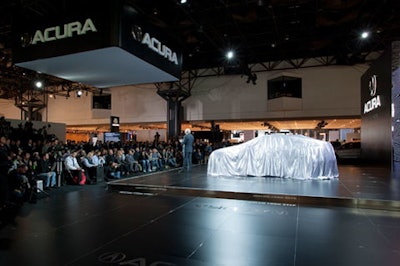The spectacle of pyrotechnic-fueled product launches and million-dollar concept cars might look a bit out of place while consumer spending is down and the U.S. auto industry's fate remains unclear. So at this year's New York International Auto Show, press presentations and show floor displays are—for the most part—predictably subdued. Opening to the public this Saturday at the Javits Center, the gathering marks an end to the four-month auto show season, and as automakers look back on their first collective marketing push of the recession, most remain committed to maintaining a presence at the shows.
It’s easy to forget that most car companies haven’t actually been making headlines. While Detroit's big three get attention for flagging sales and Japanese giants such as Toyota usurp the American market, countless smaller brands like Suzuki have flown under the radar. “The people who come to auto shows aren’t usually brand loyalists,” said Suzuki vice president of marketing Gene Brown. “They’ll consider trying something new, so we take the shows as an opportunity to offer an experience and introduce the brand as a whole. Arguably, the more established brands really don’t need to use the auto shows for that.”
Those established brands don’t see it that way. Last year, General Motors lost its status as leader in global sales for the first time in nearly eight decades, and 2009 has thus far been marked by regime changes demanded by the federal bailout and constant speculation about bankruptcy. Its budgets for auto shows have been cut drastically, but aside from canceling a press conference at the Los Angeles Auto Show in November, the company has maintained a consistent—though thrift-conscious—presence at all 65 of the domestic auto shows it visited last year.
“We’re spending 50 percent less money on our presentation in New York than we did last year,” said GM director of global auto shows Scott E. Fosgard, who went on to mention that the company’s showings in Chicago and Detroit came in at one-third and one-tenth of recent costs, respectively. Staying well under budget while keeping the focus on the automobiles and the company’s evolution is the new approach to the shows, and it’s evident in the modestly decorated displays and spartan presentation stage.
“Pulling out of the presentation in Los Angeles,” Fosgard said, “that’s probably something we regret. People write about you whether you’re there or not, so you have to show them something positive. Now it’s just a matter of being much smarter about how we reach out to people.”
In New York, GM is focusing consumer outreach on continuing the dialogue with potential buyers outside of the convention center. The company hopes to accomplish that with more interactive video displays than previous years and new technology, such as iPhone and PDA applications that make it easy for potential buyers to leave with information about different display models.
Still, many attendees come to auto shows just to ogle the concept cars and fantasize about widely unattainable brands. And the reality that few Americans are in the market for $300,000 cars hasn’t deterred many luxury brands from putting on displays and presentations. “The luxury market has certainly been affected by the crisis, but our approach with the auto shows hasn’t changed,” said Bentley Motors president and chief operating officer Christophe Georges. “I think it’s important to contribute for the overall benefit of the auto industry, and it’s our responsibility to the brand to maintain consumer interest. It’s not a matter of everyone who attends being able to afford a new car, it’s a matter of showing them products that excite them.”
During the first day of press previews at the New York International Auto Show on Wednesday, the economic crisis was a recurring topic of conversation, but it didn’t cast a pall over the show floor. In fact, most brand representatives were optimistic about the immediate future of the industry. “What I think we’re seeing right now is a pent-up demand for cars,” said GM assistant director of auto shows Tim Peters, who is charged with executing the displays at all of the company's global shows. “People are in the market for new vehicles, but what we’re hearing from dealerships is that customers just aren’t finding credit or getting leases. Financing will open up a little by summer, and I think you’ll see a lot more people buying.”
Convincing people to buy cars is the optimal endgame for pretty much every brand investing time and money in auto shows, but first it’s a matter of getting bodies onto the floor. Attendance at January’s North American International Auto Show in Detroit was down 6 percent from 2008, suffering its sixth straight year of decline.
It’s far too early to tell if New York’s audience will be on par with last year’s 1.1 million, and producers are frank about their expectations. “We won’t know exactly how many people stop by until the end of the run,” said show director Candida Romanelli. “Online registration has been consistent with what we’ve seen in previous years, so that should be telling. We’d just be thrilled if it stayed flat with last year. You know, flat is the new up.”




















